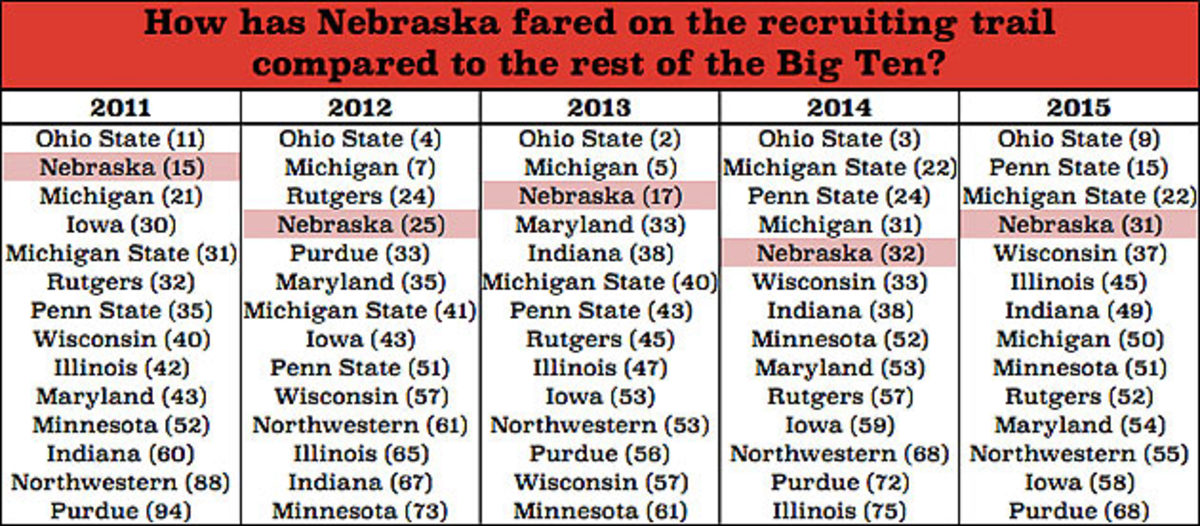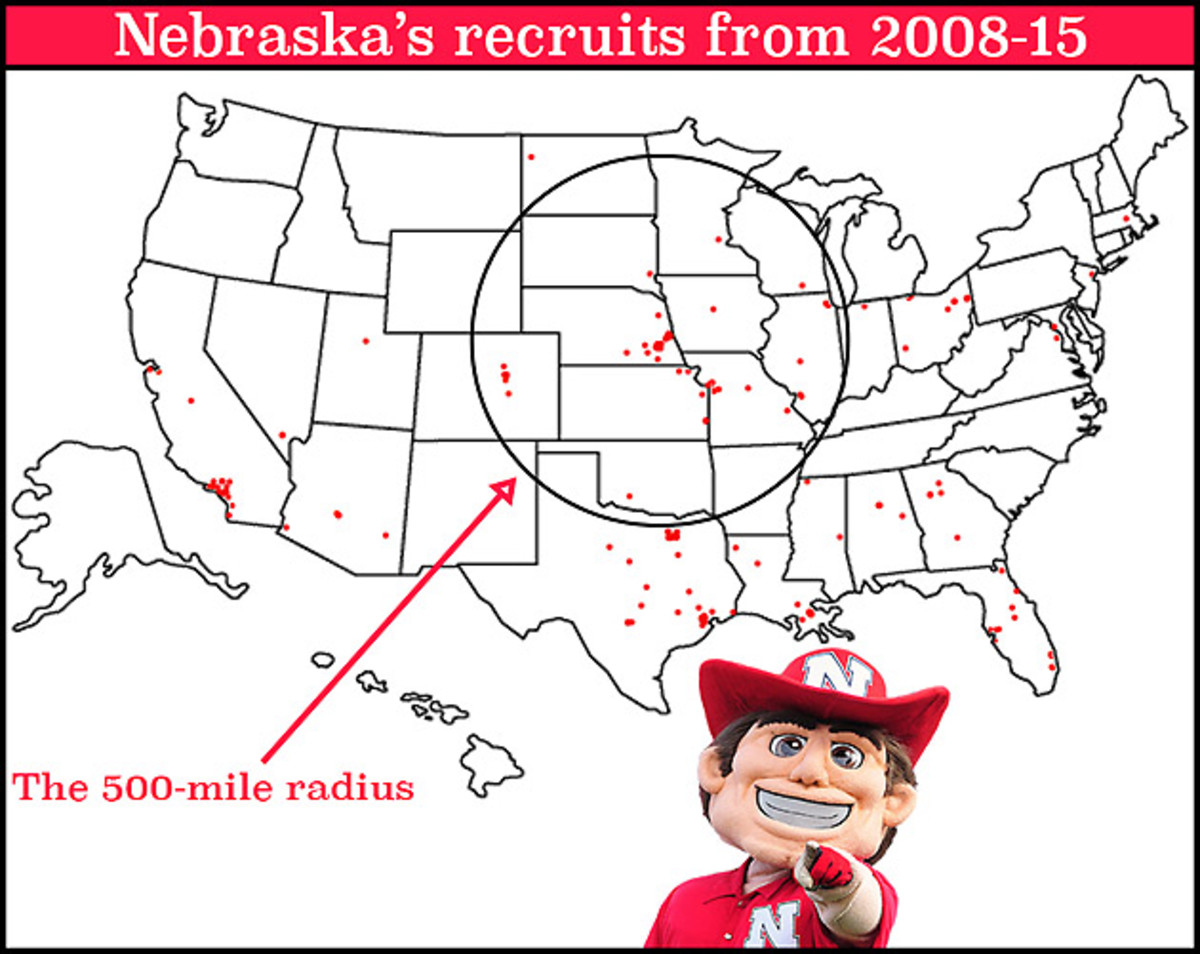Can Mike Riley improve Nebraska's recruiting? Sizing up his challenge

When Nebraska hired Mike Riley as its new head coach in December, one of the main questions that emerged was whether he could recruit the talent required to fuel a more successful tenure than his predecessor. The Cornhuskers posted at least nine wins in each of Bo Pelini’s seven seasons at the helm but failed to win a conference championship and never factored into the national title race.
That is an acceptable run for some programs and an outstanding one at others, but not at Nebraska, where the standard for success is perhaps unreasonably high. To reach that level, Riley needs to not only recruit elite prospects, but also to develop them effectively. Yet before assessing Riley’s recruiting forecast, it’s instructive to look back on the Huskers’ recent history of acquiring talent.
Since 2011, Nebraska’s first season in the Big Ten, its recruiting classes have ranged between the second and fifth highest-rated in the league, per Rivals.com. The high point came in ’11, when the Huskers signed the No. 15 class in the country, four spots behind Ohio State. In ’12 Nebraska was 25th and fourth in the conference, followed by 17th and third in ’13, and 32nd and fifth in ’14. After Signing Day last Wednesday, its class checked in at 31st and third, respectively.
The chart below shows how Nebraska’s recruiting has compared with the rest of the Big Ten's since realignment. Ohio State has finished with the top-ranked class in the league every year since 2011, while teams like Wisconsin and Michigan State have competed for conference titles despite reeling in less-heralded hauls. That blueprint did not produce desired results for Nebraska.

*number in parentheses is national rank
So, the question becomes: Why has Nebraska struggled to land prized recruits?
Analysts point to several reasons, but chief among them is location. Simply put, the state of Nebraska does not produce enough FBS-caliber players to sustain a perennial winner. Nebraska has bore six top-100 prospects since 2002, according to Rivals.com, four of whom have chosen the Huskers, and none since ’09.
Given the dearth of talent residing within state lines, Nebraska has tapped into other locales. However, the acceleration of the recruiting cycle has made long-distance courtships cumbersome. That’s especially true since NCAA rules stipulate recruits must wait until their senior years to take official visits, for which expenses are paid. By contrast, recruits must cover costs for unofficial visits, which can be expensive for the players Nebraska pursues who do not live near Lincoln.
With prospects often making verbal commitments during their junior years or earlier, it can be tough for schools to sign those who aren't hosted on campus prior to taking official visits. Nate Clouse, a recruiting analyst for HuskerOnline.com, said Nebraska has struggled to overcome negative stereotypes about its setting.
“Especially since recruiting these days has been ratcheted up so fast, you’re having sophomores and juniors in high school making their commitments,” Clouse said. “So, it’s really key to get those kids on campus and to be able to show them what you have to offer and sell them on the fact that really you have more than just cornfields and football in the state of Nebraska.
Why prized recruits should refuse to sign the NLI; more Punt, Pass & Pork
“Every kid I talk to, when they visit Nebraska, they say, ‘Wow, I was really impressed. I was expecting it to be all cornfields, and it was nothing like that.’ That’s the hurdle that Nebraska has to face -- is kind of the stigma that surrounds the state that’s in the middle of the country and in a place that a lot of these kids don’t get to unless they take an official visit where the school can actually pay their travel to Nebraska.”
The Huskers, like many other programs, have long emphasized owning the 500-mile radius around campus. But that region has not been as productive as it once was. Nebraska took on 55 percent of its scholarship recruits from that area between 1983-1990, compared to 33 percent from 2008-15.
Though Riley said his staff -- which is used to recruiting in a tough locale coming off his 12-year tenure at Oregon State -- is still formulating an approach, one main directive is to establish a strong presence within the 500-mile radius. “We looked historically at the number of guys that have come from the 500-mile radius, and it’s substantial,” Riley told SI.com on National Signing Day. “And it’s also an area where we get involvement from high school programs and coaches’ visitations, personal relationships that we can develop with our staff.
“It cannot be and won’t be our exclusive recruiting areas. We’ve kind of looked at that 500-mile radius as kind of the heartland, and we do want to really be extensive, an extensive presence in that area.”
Ryan Gunderson, Nebraska’s director player of personnel, outlined the program’s recruiting philosophy under Riley. He said the plan is to designate a primary area for each of the school’s nine assistants within the 500-mile radius, and a secondary area outside of the region. According to Gunderson, the primary recruiting areas will be: Colorado, Nebraska and the Dakotas, Minnesota and Wisconsin, Iowa, Missouri, Kansas, Oklahoma and northern Arkansas, Illinois and Indiana.
The Huskers will also focus on secondary areas outside of the 500-mile radius, including in California, where Riley and his staff have developed relationships with many high school coaches from their time in Corvallis. A review of Nebraska’s recent signing classes shows the school was already making inroads in the Golden State.

Nebraska can also help offset its location disadvantage by using satellite camps, which allow coaches to get face time with recruits before their senior years without the burden and cost of an unofficial visit. “I think it’s useful for everybody in terms of being able to get out and develop relationships with other coaching staffs, but also you see some kids,” Gunderson said. “It’s really more about developing an identity in areas that are a little further away from your own recruiting base.”
While location is paramount, perhaps a more pressing question is whether the Huskers’ brand still resonates with prep players. This generation’s recruits did not grow up with Nebraska as a dominant program that regularly competes for national titles. Still, Riley said the Nebraska name has already helped his staff sway players, even if they didn’t ultimately sign with the Huskers.
USC leads Rivals.com's top 25 team recruiting rankings for class of 2015
The initial positive response bodes well for Nebraska’s chances of connecting with prospects both inside and outside the 500-mile radius.
“We went in on some very, very highly rated players, which a lot of it turned out too late, but felt good about the entry into the conversation because all of a sudden, now that Nebraska is in on it, it turned their heads a little bit,” Riley said. “I still think that the best recruiting is done over a period of time where you can build a relationship and trust, and that’s your best chance to get a kid.
“I was impressed by the fact that, even though we were late, and maybe not as relevant because we were so late, they were interested because it was Nebraska.”
In the end, though, the most important thing Nebraska can do is simple: Win more meaningful games. In a Big Ten West with no established powers, the Huskers are well positioned to compete for conference crowns. Nebraska lost its only appearance in the Big Ten title game but could make a recruiting splash with some success -- particularly in a league that now features Urban Meyer, Jim Harbaugh and James Franklin.
All ranking and star data comes from Rivals.com.
